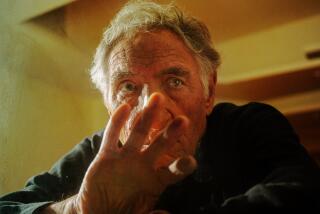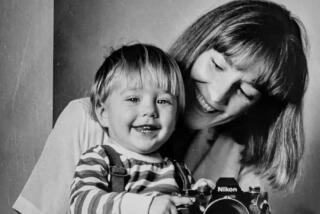Giselle Freund; Photographer Excelled in Portraits
- Share via
Giselle Freund, a photojournalist who never intended to be an artist but produced quintessential images of major artistic and literary figures, died Friday of a heart attack at a Paris hospital. She was 91.
A pillar among French feminist intellectuals after arriving in Paris from Germany in 1933, Freund did documentary work for a number of publications, including Life, Picture Post, Paris Match and Weekly Illustrated.
She established herself as a witness to history--producing critically acclaimed photo essays on English slums, the city of Buenos Aires and Evita Peron--but her passion was portraiture.
As a portraitist, Freund revealed the character of her famous subjects in strikingly sensitive pictures that appear elegantly composed but are actually candid. Shot mainly in Paris and London from the 1930s through the ‘70s, her portraits compose a Who’s Who of 20th century art and literature. Among her artist models were Henri Matisse, Pierre Bonnard, Jean Cocteau, Man Ray and Marcel Duchamp. Her long list of literary subjects included Virginia Woolf, Colette, Simone de Beauvoir, James Joyce, Andre Gide and Andre Malraux.
Ever watchful of people around her, she snapped a picture of writer John Steinbeck on the sly as he signed traveler’s checks at the American Express office in Paris, but most of her subjects agreed to be photographed because of her genuine interest in them and their work.
They rarely liked the results, however.
“They were accustomed to retouched studio portraits,” Freund told a Times art writer some years ago.
Undaunted, she became known as a crusty, high-spirited but warmhearted photographer who never posed her subjects. “My talent is to go to the esprit of the person. I have a gift for putting myself into someone else, to forget myself so that the photographer disappears,” she said.
In 1982, when an exhibition of her photographic portraits appeared at the Koplin Gallery in Los Angeles, a Times art critic praised Freund’s ability to find something new and telling in familiar faces: “What makes the photographs unusual is a rarely flagging freshness of vision that convinces us again and again that we are seeing rare shots of people who are in fact among the most photographed of their time.”
Born in Berlin to a wealthy Jewish family and raised in Frankfurt, Freund became acquainted with the art world through her father, an art collector who took her to galleries to see paintings. The first photographs that made a lasting impression on her were in a book of works by Karl Blossfeldt, whose illustrations of plants transformed delicate natural forms into monumental structures.
At 15, she received a camera as a gift from her father. But Freund wanted to be sociologist and studied sociology and art history at the University of Frankfurt. She became politically active against Hitler, who was then on the rise. Allied with a group of students who published an anti-fascist newsletter, she landed on the Nazis’ hit list in 1933. After a colleague was arrested and killed for distributing the newsletter, Freund fled to Paris.
She continued to study sociology at the Sorbonne but without her family’s financial support; by then Hitler had placed curbs on money leaving Germany. Freund was faced with having to make a living and turned to photography.
Her first assignment was to photograph children in the Luxembourg Gardens in Paris. Her talent was apparent, and she soon began to receive significant commissions.
In 1935 she made what turned out to be a famous photograph of Malraux for the dust jacket of “Man’s Fate.”
The image was chosen for reproduction on a French postage stamp and poster in 1996, marking the 20th anniversary of the author’s death. But the cigarette clamped between his teeth was airbrushed out, rendering the chain-smoking national hero fit for public consumption according to today’s standards. “We aren’t allowed to promote cigarettes,” a Culture Ministry spokesman said.
Freund completed her doctoral work at the Sorbonne in 1936, writing her thesis on 19th century French photography. By then, she was shooting for Life magazine, which she continued to do throughout the 1930s.
A scholar as well as a shrewd observer of people, she wrote several photography books, including her autobiography, “The World in My Camera,” and “Photography and Society,” a standard French textbook on photojournalism.
In her later years Freund was fascinated by the technological changes that transformed photography, but she expressed reservations about the limitations of automation. There is no substitute for the person behind the camera, she said. “The human eye is the only thing we cannot replace [with a machine]. One of the few choices left is what to photograph.”
More to Read
The biggest entertainment stories
Get our big stories about Hollywood, film, television, music, arts, culture and more right in your inbox as soon as they publish.
You may occasionally receive promotional content from the Los Angeles Times.










